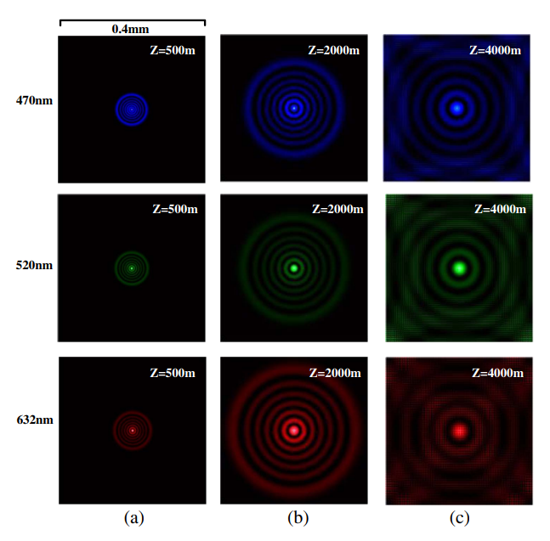Underwater optical wireless communication is very useful for many kinds of applications such as oceanography, environmental monitoring, and underwater surveillance. However, it suffers from extreme optical absorption and Mie-Rayleigh scatting in the water or seawater. Even if blue-green wavelengths as a distinct transmission window of the seawater for underwater optical wireless communication also suffer the Mie-Rayleigh scatting from water molecules, salt ions and phytoplankton and other transparent biological organisms. To develop underwater optical wireless communication, it is necessary to solve the problem from the Mie-Rayleigh scatting. Bessel beams or Bessel-like beams as non-diffracting and self-reconstructing beams are not attainable in conventional Gaussian beams optics limited by the classical Rayleigh range and overcome the underwater particle scattering effect to some extent.
Recently, there are many methods to generate Bessel beams, such as axial cone lens, cavity method of optical system, fiber-based method and so on. Compared with conventional bulky optical systems, Bessel beams or Bessel-like beams generated by optical fibers-based method are desirable that is because they could offer a compact, robust and alignment-free operation. There are many fiber-based methods for generating Bessel-like beams, such as fiber microaxicon, self-growing micro-tips or a tapered hollow tube. Another way is utilizing a long-period grating to excite LP0m modes and then produce Bessel beams with controllable diffraction-resistant distance. These non-diffracting Bessel-like beams have attracted increasing interest owing to their unique light intensity distributions and self-healing propagation properties, which have been widely using in various domains such as optical trapping and manipulation, high-order harmonic generation, nonlinear optics, material processing and so on.
The underwater Bessel-like beams introduced by Dr. Xiaoying He from a research group from Beijing University of Posts and Communications in Chinese Optics Letters , Vol. 20, Issue 7, 2022 (X. He, et al, Underwater Bessel-like beams with enlarged depth of focus based on fiber-microaxicon) is generated by fiber microaxicon and simulated by using beam envelope propagation method, henyey-Greenstein-Rayleigh phase function and Monte Carlo methods.
When the 470nm, 520nm and 632nm light incident into the cone of the fiber microaxicon, underwater Bessel beams with enhanced focusing depth of 28 μm, 36.12 μm and 50.7 μm had been obtained due to the formation principle of the refraction,as shown in Figure 1. In water, when the cone Angle of the fiber microaxicon reaches more than 60 degrees, Bessel beam can be generated, greatly reducing the difficulty of the fiber microaxicon fabrication and its Bessel beam generation.

Figure 1. Transverse power distributions of Bessel-like beams with the blue (470 nm), green (520 nm), and red (632 nm) lights generated by the fiber microaxicons underwater for propagation at (a) 500 m, (b) 2000 m, and (c) 4000 m.
A conventional Gaussian beam, underwater, affected by Mie-Rayleigh scattering, can travel only up to 500 meters, after which the energy of the light is hard to reach the detectable level. The enhanced depth of focus of visible Bessel-like beams could improve the propagation distance underwater, which has been simulated to solve the problem of the propagation distance of Gauss beam low to 1000 m about the underwater optical communication. In the future, the research group will focus on a more simple and easy way to generate Bessel beams and the application of Bessel beams in underwater wireless optical communication.
Dr. Lan Rao from Beijing University of Posts and Communications believes that Bessel-like beams can be utilized in underwater optical wireless communication to enhance the optical wireless propagation distance. The method is simple and reliable and can be flexibly used in underwater optical wireless communication.


